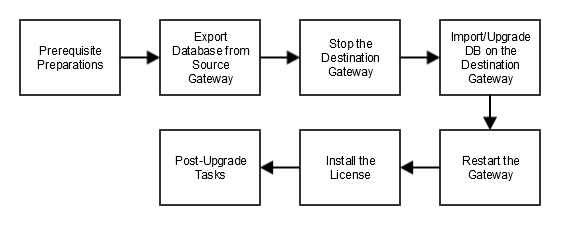Upgrade Scenario 1 - Database with the Gateway
The most common upgrade scenario involves upgrading a gateway that includes a MySQL Gateway database on the same node. In this scenario, you create a new virtual instance of the latest Gateway version, and then move the database and supporting files over.
gateway92
The most common upgrade scenario involves upgrading a
CA API Gateway
that includes a MySQL Gateway database on the same node. In this scenario, you create a new virtual instance of the latest Gateway version, and then move the database and supporting files over. If your system is configured such that the database resides on a separate host, see Upgrade Scenario 2 - Database on Separate Host instead.
expedited_scenario_1

Workflow:
- Perform the prerequisite preparation steps. This involves standing up a new virtual Gateway, configuring replication, and purging audits.
Before You Begin
- Set up a new Gateway with your destination version. Be sure to use the same passphrase for the cluster passphrase as the source Gateway.For more information about how to set up a new virtual appliance:
- See theCA API Gateway Virtual Appliance Getting Startedunder "CA API Management Technical Documentation" in Release Notes 9.3
- If you are setting up a cluster of Gateways, set up replication first, then configure the first processing node, and then subsequent nodes.For more information, see:
- (Optional) Save your audit events from the source Gateway. All audit events are discarded as part of this upgrade process.For more information, see "Download Audit Events" in View Gateway Audit Events.
- Purge audit events from the source Gateway. For more information, see "Delete Audit Events" in View Gateway Audit Events.
- If you are upgrading the database after Gateway patch installation, ensure that you either have the Administrative Database user (root)privileges or grant the user with similar privileges for successful upgrade.
Step 1: Export Database from Source Gateway
- Access the privileged shell on the source Gateway.
- Run the following command to export the Gateway database:# mysqldump ssg --routines > /home/ssgconfig/<source_Gateway>.sqlWhere"<source_Gateway>"is any label that indicates the .sql file is the database from the source Gateway.
- Copy the database from the source Gateway to the destination Gateway:# scp /home/ssgconfig/<source_Gateway>.sql ssgconfig@<destination_Gateway_Hostname>:~/
Step 2: Stop the Destination Gateway
Perform these steps on
every
node on the destination Gateway:- Access the privileged shell.
- Stop the node with this command:# service ssg stopThe 'ssg' service must be stopped on all nodes, otherwise the upgrade is not successful.
Step 3: Import and Upgrade the Database on the Destination Gateway
Perform these steps on the primary node only:
- Access the privileged shell.
- Run the following commands:# mysqladmin drop ssg# mysqladmin create ssg# mysql ssg < /home/ssgconfig/<source_Gateway>.sql# service ssg start# exitYou return to the Gateway main menu.
- Select option2(Display CA API Gateway configuration menu) from the Gateway main menu.
- Select option1(Upgrade the CA API Gateway database). Confirm the upgrade. Allow several minutes for the upgrade to complete.
Step 4: Restart the Gateway
After you have imported and upgraded the database, restart the Gateway cluster.
- Access the privileged shell again.
- Restart the Gateway by running this command on every node:# service ssg restart
Step 5: Install the License
- Start the Policy Manager and connect to your destination Gateway.
- Install?the license file.
Your destination Gateway is now operational.
Step 6: Post Upgrade Tasks
Some items cannot be brought over automatically in the expedited upgrade process. Manually complete the following tasks that apply to you:
- Custom assertions:Any custom assertions that were present in your source Gateway must be reinstalled on the destination Gateway.For more information, see Install Purchased Custom Assertions.
- Non-default assertions in your source Gateway:Certain assertion files are not be included in the upgrade. You must copy these files manually from the source Gateway to this directory on the destination Gateway:runtime/modules/assertionsAn example of non-default files is the.AAR files for modular assertions.
- Copy .JAR files:You must copy all .JAR files from the source Gateway to these directories on the destination Gateway:/runtime/lib/ext/runtime/libThe .JAR files are required for some features to work (for example, JDBC or JMS).
- Modify iptables:If the source Gateway had port redirects in theiptablesfile, you must reapply these manually on the destination Gateway.